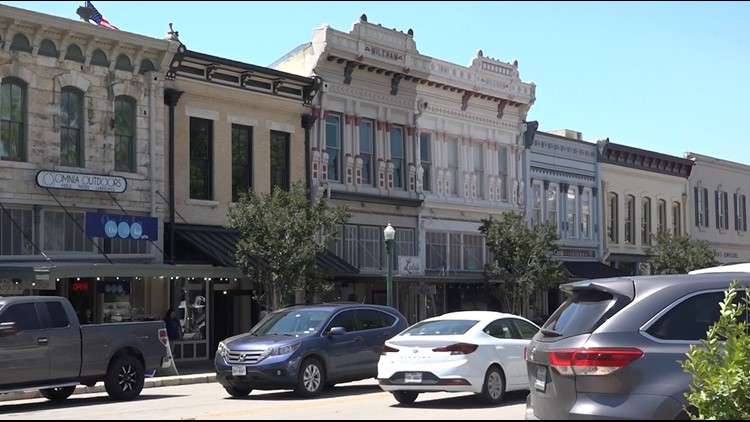
WILLIAMSON COUNTY, Texas — Twenty years ago, Williamson County was a reliably red political county, but that has changed as the county has become a political battleground in recent years. In 2024, voters in the county supported President-Elect Donald Trump over Vice President Kamala Harris by two points, but backed Rep. Collin Allred over Sen.
Ted Cruz by one and a half points. Mark Jones, a political science professor at Rice University, noted ticket-splitting among some voters, as Cruz underperformed Trump and Republicans in statewide races for Supreme Court, Court of Criminal Appeals and Railroad Commissioner. "By and large, he generates less support and has less crossover appeal than Trump or your generic Republican, and Colin Allred, simultaneously, was able to generate more support among crossover voters than both Kamala Harris, but also all the other Democrats running at the county level and statewide," Jones said.
"Trump had about a six-point advantage statewide over Cruz, and in a pink county like Williamson County, that's the difference between being on the winning side and losing side, with Cruz just over on the losing side of the race [in the county]." Political observers attribute Williamson County's trends over the past decade to the county's constant population growth. "It has generally gone from ruby red to either pink or purple," Jones said.
Joe Biden narrowly won the county in 2020. In 2016, then-candidate Donald Trump received more than 104,000 votes in Williamson County, while Hillary Clinton received nearly 20,000 fewer votes. In about a decade, the county's population has grown by 44%, from 422,679 in 2010 to 609,017 in 2020, according to the U.
S. Census Bureau. "More population and has also brought a greater demographic variety and heterogeneity in the state," James Henson, the Director of the Texas Politics Project at the University of Texas Austin, said.
"This means more Hispanic and black voters in the district and, inevitably, more Democrats." Political observers believe that the movement is driven by the growth of the Austin Metro and people moving from the city of Austin to the county to find more affordable housing, amenities and living. "As people who live and work in Austin move to Williamson County, they bring their politics with them, thereby creating greater Democratic reservoirs of support in the county," Jones said.
"You still have in Williamson County a reservoir of Republican votes, both in the suburban areas, but especially in the more outlying areas of the country that serve as a bulwark against this Democratic advance." In 2018, Williamson County voted to elect MJ Hegar, then-candidate for the U.S.
House of Representatives - to District 31, and Beto O'Rourke, then-candidate for U.S. Senate, although neither won their election.
Four years later, in 2022, Gov. Greg Abbott reversed the trend and defeated O'Rourke in Williamson County during the gubernatorial race. Henson said the reason that the district swings back and forth is that there are different cultures in different parts of the county.
The Democratic stronghold is closer to the Travis County line, and the Republican stronghold is on the outer reaches of the county on the northern, eastern and western boundaries. "If you break it down into some of the legislative districts that are carved out of Williamson County, you find some areas where Democratic voting is heavy," Henson said. "You find other areas where Democrats are not viable.
" Another factor, Jones said, is a subset of migrants who are leaving Travis County because they think it's too progressive and don't like the quality of life. Those votes will likely vote against Democratic policies because they don't want to see Williamson County become another version Travis County. So, voters who may lean Democrat, Independent or moderate Republicans may still vote for Republican judges, sheriffs and district attorneys.
"The negative experience that many Austin residents have are the negative experience that many Travis County residents have had with their district attorney, and the crime issue in the county may result in many of them who vote, say for Collin Allred towards the top of the ticket, voting for Republicans for positions related to Criminal Justice, like sheriff and district attorney and judge, because they do not want To see Williamson County become like Travis County, which is something that they fled," Jones said. "For people who believe that Austin has a crime problem and that Travis County is soft on crime, they're going to have a negative disposition just naturally towards Democratic candidates because they view Democratic candidates as being the source of many of the problems that, today, Travis County suffers from." But by and large, Jones said Williamson is a county that will be consistently in play over the course of this decade.
As for whether the voters there elect Democrats or Republicans to local, state and federal office, Jones said it will depend significantly on the candidates, the campaigns, the policies and the national and state conditions. "When those favor Republicans, they're likely to sweep the entire county," he said. "If the Republicans have a weaker candidate, or Democrats have a stronger candidate, or the national or state economic conditions don't favor Republicans, then a Democrat can win in Williamson County.
" Over time. Jones says he thinks Williamson County could evolve more like Hays County, which was also a Republican county not long ago, but has shifted to being a consistently Democratic county in recent years..














